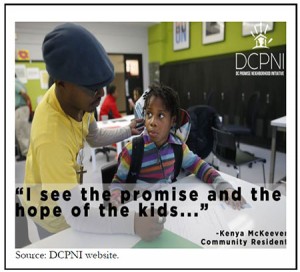 DC and a number of communities across the nation have launched “Promise Neighborhoods,” built on the model of the Harlem Children’s Zone. These initiatives bring community partners together to address education, health, and social services supports in targeted low-income communities. DC’s Promise Neighborhood Initiative (DCPNI) — in the Kenilworth-Parkside community of Ward 7 — has received substantial federal and private funding, launched a number of activities, and recently hired a new leader. It also has faced some challenges, such as the closing of a public school within its boundaries.
DC and a number of communities across the nation have launched “Promise Neighborhoods,” built on the model of the Harlem Children’s Zone. These initiatives bring community partners together to address education, health, and social services supports in targeted low-income communities. DC’s Promise Neighborhood Initiative (DCPNI) — in the Kenilworth-Parkside community of Ward 7 — has received substantial federal and private funding, launched a number of activities, and recently hired a new leader. It also has faced some challenges, such as the closing of a public school within its boundaries.
What is happening at DCPNI? DCPNI is working to tackle poverty with over 40 partners that offer services for children and their parents, from early learning programs for young children to workforce development and technical training courses for parents. The DC Promise Neighborhood staff act as a coordinator and convener for these partners.
Two partner organizations, the Educare DC Early Learning Center and Unity Health Care, opened new facilities there in 2012. DCPNI also helped launch summer and out-of-school-time services that year, including its Digital Media Academy, the Tiger Woods Learning Center, the Boys and Girls Club, and Save the Children.
How is DCPNI funded? The DC Promise Neighborhood Initiative received a planning grant from the U.S. Department of Education in 2010, and it landed a $20 million, five-year federal implementation grant in 2012. It has received additional support from Community Foundation of the National Capital Region, the Consumer Health Foundation, the Lois and Richard England Family Foundation, Washington Area Women’s Foundation, JP Morgan Chase, and DC LISC, among others. It does not receive funding from the DC government.
New leadership at DCPNI. Mary Brown was announced as DC Promise Neighborhood Initiative’s new Executive Director in June 2014. In an interview with the DC Fiscal Policy Institute, Ms. Brown highlighted her ambitious goals and hopes, noting that “this community inherently has everything it needs to uplift itself”¦We [DCPNI] will serve as a backbone, a catalyst, and a broker.”
Ms. Brown emphasizes the need to address issues of privilege and cultural conflict that are bound to be present in such an effort. Partners are now required to go through an orientation that addresses issues of race, class, and gender.
What challenges has DCPNI faced? The DC Housing Authority’s application for a $30 million federal Choice Neighborhoods grant to overhaul the Kenilworth Courts housing project was turned down. However, the community still hopes to attract a grocery store and other retail, to avoid having residents cross a major highway to access these amenities.
The recent closing of Kenilworth Elementary School, one of three schools in the Promise Neighborhood, was another setback. The school boundary changes recently adopted by Mayor Gray includes a recommendation to reopen Kenilworth, which would enable more residents to send their children to school in the neighborhood. Nearly 70 percent of children in Kenilworth-Parkside now attend school outside the neighborhood.
What’s next for DCPNI? In the coming months, DCPNI’s Parent Advocates program will begin assigning case workers to children in the community and launch a program focused on parents, which will include everything from accessing GED and job training to financial management and involvement in their children’s education. Moving forward, DCPNI aims to become a leading employer of Kenilworth-Parkside residents and expanding the programs that are most successful in lifting residents out of poverty.
For more information on the DC Promise Neighborhood Initiative, see http://dcpni.org/.
To print a copy of today’s blog, click here.
